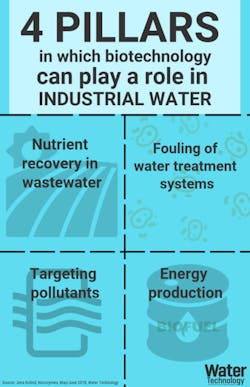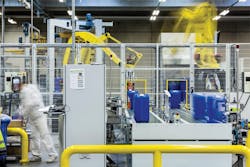Biotechnology has been used for thousands of years to make bread, wine, cheese and beer, but only in the last 50 years or so has it been used for industrial purposes. The range of biotech applications is rapidly expanding, and it is particularly well-established in the production of everyday products from laundry detergents and textiles to animal feed and biofuels. However, the take-up in water is now gathering apace.
Biotechnology is transforming industry
Biotechnology has already transformed a number of industries and provided a huge impact in environmental benefits. According to Jens Kolind — vice president of Novozymes, a Danish company specializing in the use of microbes and enzymes in agricultural and industrial applications — the water industry is perfectly placed for a "paradigm shift" by taking advantage of the research behind these advances.
Capturing phosphorous from wastewater for reuse as fertilizer is a clear example.
"Some of the microorganisms being applied in the agricultural sector, for example those used to enhance the health of plants, can also be applied in the context of water where phosphorous needs to be extracted from the waste stream for reuse," Kolind said.
On a broad level, Kolind said there are four pillars where biotechnology can play a big role in the water industry: nutrients in wastewater, fouling of water treatment systems, energy production and specific pollutants. Each has gained some experience from a parallel sector.
“There are four pillars where biotechnology can play a big role in the water industry: nutrients in wastewater, fouling of water treatment systems, energy production and specific pollutants. Each has gained some experience from a parallel sector.”
"In terms of nutrients in wastewater, classical phosphorous and nitrogen recovery and removal, we already have experience from the agricultural sector," Kolind said. "In dealing with biofilm and fouling of water treatment systems, we have experience from detergents.
"The third area is on the energy side — biogas production and obtaining value out of the sludge, where we already have learning from bioenergy development. And last but not least, there’s targeting specific pollutants in wastewater and process water where we draw on microbes and enzymes that can degrade inorganic or organic pollutants such as pesticides."
Microbial insight
Kolind said that genomic information greatly enhances understanding of microbial communities — known as metagenomics — and will be incredibly important in the water industry.
"To give a concrete example regarding wastewater treatment, if you run a biological treatment process, most plant operators today don’t understand the types of microorganisms in that big soup of biology. Using metagenomic technology, they can know exactly what’s in that soup, which microorganisms and what proportions.
"They can work out how it compares to other wastewater treatment facilities and how to use that information to add in specific microorganisms needed to target a specific compound, phosphorous, perhaps. That capability has the potential to be transformative in the way we look at wastewater treatment plants and in generating a step-change in biological treatment of wastewater."
Kolind says the cost of this in-depth analysis has decreased significantly over the last five years.
"When you take a wastewater sample, within one or two days you get information you can act on — if the microbial community is not functioning in the way that it should — so I think that area is really exciting."
When it comes to developing new microorganisms or enzymes that can target specific parameters, such as high COD, or specific compounds, "the toolbox" has expanded significantly, Kolind said.
Jerricans of enzymes at Novozymes production facility in Bagsvaerd, Denmark
Robotic screening in biotechnology
"Today, we are not looking at only 50 or 100 different enzyme or microbe variants to find the exact microorganisms or enzyme to target a specific compound," Kolind said. "Using robotics, we are looking through millions and millions of variants."
Some observers see the advances in biotechnology as part of the green revolution required for the global agricultural industry to continue feeding the planet’s 6 to 7 billion people. Water for irrigation, industry and domestic use is also a key requirement of human sustainability.
The question is, are we at the sunset or sunrise for a biotech revolution? Kolind believes that the industrial space for biotech is still in its early days.
"If you look at the total market for industrial biotechnology, the penetration of biotechnology is still fairly low," Kolind said. "In areas like agriculture, pharmaceuticals and bioenergy where biotechnology plays a significant role, you still have a good way to go. The way Novozymes looks at it, is that we are still in a big industry that has a big growth potential, and we are not over the blockbuster period yet."
Editor’s note: Jens Kolind will present a keynote address on trends in biotechnology and its impact on water and the circular economy at BlueTech Forum in Vancouver, Canada, on June 6-7. He will also lead a roundtable on biotechnology. Visit bluetechforum.com to register for the event.
Paul O’Callaghan is the CEO of BlueTech Research, a global provider of market intelligence for the water industry.



